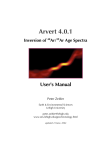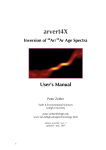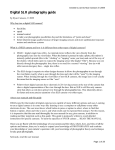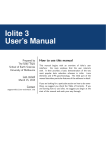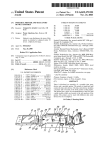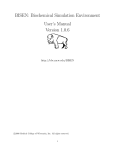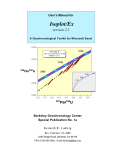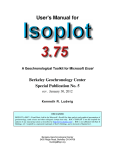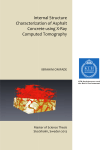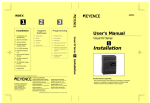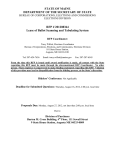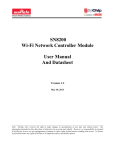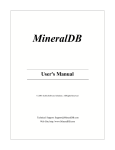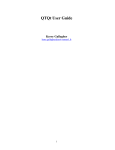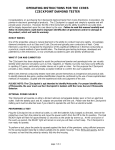Download Arvert 4.1 manual - Earth and Environmental Sciences
Transcript
Arvert 4.1 Inversion of 40Ar/39Ar Age Spectra User's Manual Peter Zeitler Earth & Environmental Sciences Lehigh University peter.zeitler@lehigh.edu www.ees.lehigh.edu/geochronology.html release arvert4.1.0 updated 7 April, 2012 1 User Agreement Arvert is freeware. You can download, use, and modify it without cost. However, your use of Arvert is subject to the following conditions: • Please acknowledge use of this code • You can’t sell or charge for the use of Arvert code, modified or not • Please notify me of any non-trivial changes you make • I’ll try to help you if I can, but I’m under no obligation to provide technical support in the downloading, compilation, operation, or use of this program. • Lehigh University and Peter Zeitler take no responsibility for any errors that might arise during the use of Arvert, due either to the code itself or in the instructions for its use, and are not liable for any consequences of such errors. I do promise to express chagrin if you find a howler. • Please notify me of any bugs you find, and pass along suggestions for improvements. 2 Contents 1. Introduction .......................................................................... 1.1 What is Arvert? ......................................................... 1.2 How does Arvert work? ............................................ 1.3 How is Arvert best used? .......................................... 1.4 What’s different about Arvert 4.1? .......................... 4 4 4 7 8 2. Obtaining and Installing Arvert .......................................... 2.1 Getting code or applications ..................................... 2.2 Overview of running the application ........................ 2.3 Compiling the code ................................................... 10 10 10 11 3. Using Arvert .......................................................................... 3.1 Program inputs and outputs ...................................... inputs (file crs.in) .................................................. inputs (file domains.in) ......................................... inputs (file goal.in) ............................................... inputs (file helium.in) ............................................ outputs ................................................................... 3.2 Viewing results ......................................................... 3.3 Modeling considerations ........................................... while modeling ..................................................... when you’re done.................................................. 3.4 Warnings and issues.................................................. 12 12 13 22 24 25 27 29 30 30 31 32 4. Special Topics ....................................................................... 4.1 History of Arvert ....................................................... 4.2 Performance .............................................................. 4.3 Future versions of Arvert .......................................... 36 36 37 37 5. References and Suggested Reading .................................... 38 6. Appendix – Convergence Sequence, Sample Results ...... 39 3 Section One – Introduction 1.1 What is Arvert? Arvert is a numerical model that inverts K-feldspar 40Ar/39Ar age spectra for thermal history. Given a measured age spectrum plus kinetic and domain parameters determined from the 39Ar released during the step-heating experiment, Arvert will try to find those thermal histories that would result in an age spectrum like the one measured. The latest version of Arvert can include mineral age data in the inversion. This manual assumes that readers and prospective users of Arvert have an understanding of geochronology and know the basic principles of thermochronology, including the multi-domain model for argon diffusion in feldspars. If the first paragraph was made no sense to you, now would be a good time to run away! 1.2 How does Arvert work? Being an inverse model, Arvert attempts to determine fundamental controlling parameters (i.e., a thermal history) from observations of a complex observed phenomenon (i.e., an age spectrum, and a mineral age). The program has two main components, a pair of forward models that can calculate an age spectrum and mineral age for a given thermal history, and an algorithm that reshapes a starting pool of random thermal histories into a set of solutions that increasingly minimize the mismatch between the calculated and observed age spectrum and mineral age. The core forward model is taken from Oscar Lovera’s original code for the calculation of age spectra from samples incorporating multiple diffusion domains (Lovera et al., 1989). Thus, at its heart, Arvert is completely dependent on the assumptions that go into the multidomain diffusion (MDD) model. There is now an extensive literature on this subject and some excellent work and reviews by the UCLA group on the validity of this Arvert 4X User’s Manual Page 4 conceptual model as a description for Ar diffusion in feldspar. If for some reason you reject the MDD model, then Arvert is not the program for you. The text by McDougall and Harrison (1999) is an excellent place to start for a discussion of 40Ar/39Ar thermochronology and the MDD model. To be clear, here are the assumptions upon which Arvert is based: Ar diffusion in feldspars occurs by volume diffusion, with similar mechanisms and kinetics operating in nature as during 39Ar extraction in the laboratory. Feldspars are divided into discrete diffusion domains of differing sizes (or diffusivity, or both). Although the code can handle domains of differing activation energy, experience shows this to be unnecessary (the code expresses variation among domains in terms of size variation but mathematically, variations in D have exactly the same influence as variations in size). Arvert assumes that variations within an age spectrum are entirely due to accumulation of 40Ar by radioactive decay and loss of 40Ar by thermally activated diffusion acting in the sample’s domain structure: it is assumed that the sample contains no extraneous Ar components or that these have been corrected for. The inverse portion of the Arvert code uses the controlled random search (CRS) algorithm of Price (1977) as adapted by Willet (1997) for the inversion of apatite fissiontrack data. This algorithm retains the advantages of a Monte Carlo approach in searching parameter space for true minima, while converging far more rapidly due to the “learning” component inherent in the CRS method. It is beyond the scope of this guide to discuss inverse methods as they have been applied to thermochronometric data; see the article by Willett (1997) and references therein as a start. Arvert minimizes the misfit between a measured age spectrum and those that it calculates. This “objective function” in the case of Arvert can take two forms, either a simple mean-percent deviation between the steps of the observed and modeled spectra and mineral age, or a mean square of weighted deviates that takes into account assigned errors on each heating step and the mineral age. In detail, Arvert works as follows. Initially, a pool of 100 to 300 thermal histories is randomly generated, subject to any constraints supplied by the operator (“explicit” constraints are in the form of Arvert 4X User’s Manual Page 5 maximum and minimum temperatures for the problem space; “implicit” constraints are in the form of maximum and minimum heating and cooling rates). An age spectrum is calculated for each thermal history and its fit parameter is determined. Next, the program goes into its main loop, and begins to sequentially create new thermal histories, keeping or discarding them depending on whether they represent a better fit than the current worst member of the pool; if a good fit is found, the worst member of the pool is discarded. The program continues until it reaches the specified number of iterations, or has brought all histories in the pool to converge within the specified limits. New CRS thermal histories are made as follows. A subset of about 10-15 thermal histories is randomly selected from the main pool, plus one more. The histories in the subset are averaged, and then a new history is made by reflecting the additional selected history through the averaged values, subject to an amplification factor that might range between 1.1 and 1.5. Figure 1 gives what is probably a more clear depiction of this process. Arvert 4X User’s Manual Page 6 Figure 1. CRS algorithm for creating a new thermal history. 1.3 How is Arvert best used? Unless you start tinkering with its code, or until you use it for a while, Arvert will appear to you as the quintessential black box, and it will be tempting to treat it as such. Avoid this temptation! Make an effort to understand what the main inversion parameters do, and how constraints and parameters can bias your results, sometimes in subtle ways. Arvert is best used to investigate what classes of thermal history might serve as explanations for a particular age spectrum, given whatever firm geological constraints you have in hand. Once you know what the possibilities are, one Arvert 4X User’s Manual Page 7 option is to then continue using manually directed forward modeling to complete the fitting of the age spectrum. However, this approach sacrifices one of the potential advantages of the inverse approach, and that is to obtain a feeling for confidence limits on various parts of the derived thermal history. With careful use and an understanding of some of its pitfalls, Arvert can provide this information (but see Section 3.5). What you should NOT do is just run Arvert once for countless iterations, and then take this single result as the truth. You must make some effort to see how different constraints influence the model, and how well your derived diffusion-domain structure is permitting the model to function (ill-defined kinetic and domain data can make it difficult for Arvert to fit parts of an age spectrum, causing over-convergence to false precision to occur for parts of the thermal history). It is important to remember that in many applications of Kfeldspar thermochronology, your goal is an understanding of process and timing, at the level of precision that geologic data and realistic, often underdetermined thermal models can provide. Given the current and improving speed of most personal computers and workstations, if you devote 1-2 hours to multiple background runs of Arvert you should be in good shape. Start by running multiple models for only a few thousand iterations each, perhaps changing the duration of the model to permit different prehistories to come into play. Try allowing some (re)heating, unless you are absolutely certain that this could not apply. Alter the number of time nodes to see whether this is introducing an artifact for your particular case. Try making a very different Monte Carlo pool at the start by changing the heating and cooling rate constraints. Alter the amplification factor. Check to see if there is a portion of your age spectrum that is not fitting well, possibly due to an error in domain structure or some pathology in your sample, or that you are modeling past sample breakdown at > 1000 ˚C. After all this, you can then try a few final runs that continue for longer durations and attempt to achieve statistical convergence. 1.4 What’s different about Arvert 4.1? Arvert 4.1 contains a few bug fixes and adds the ability to have your results plotted automatically if you have the gmt package installed. Here’s a brief description (more information is embedded as commentary in the source code). Arvert 4X User’s Manual Page 8 Bug fixes: 1. The restart option now works correctly without a file-permission error. 2. The ModelInfo file that summarizes your inversion run now correctly reports the final best and worst fits. 3. The routine that filters new CRS thermal histories now correctly handles all constraints on heating and cooling rates (previously low heating rates could slip through even if monotonic cooling with a heating rate of 0.0 had been specified). 4. Updated alpha stopping distances. New Feature. If you have installed gmt (The Generic Mapping Tools), you can ask Arvert 4.1 to produce a pair of plots summarizing your model run (the final age-spectrum and thermal-history pools are shown). This saves you the hassle of having to open Excel, select a data range, and make a plot for every run. Arvert 4X User’s Manual Page 9 Section Two – Obtaining and Installing Arvert 2.1 Obtaining code or applications Arvert source code, a compiled application, examples of inputs and outputs, and helper applications should be available at http://www.ees.lehigh.edu/geochron ology.html Alternatively, as a second resort, you can contact Peter Zeitler at peter.zeitler@lehigh.edu and I can email you the code and any applications as attachments. I use and develop Arvert under Mac OS X, so some helper applications and the compiled code may work only on Macs. Arvert 4.1 runs as a UNIX command-line application under OS X and should be very easy to port to other platforms. If you wish to use Avert on a different platform, you will need to recompile and link the source code (See Section 2.3). 2.2 Overview of running the application As just noted, Arvert runs as a command-line program in a terminal window. Until computer speeds increase by another factor of 20 or so, Arvert can’t really work as an interactive program, so the lack of a GUI isn’t a big deal. To actually run Arvert, you invoke it in standard UNIX fashion. On a Mac, launch Terminal.app, navigate to the directory containing both the executable and all needed input files, and type ./arvert41 Note that double-clicking the executable in the Finder will not work; you will cause terminal to launch and the program to start, but it will terminate in a bus error. You are then presented with a list of what Arvert thinks are your inputs. You should check these for blunders or silly values to avoid wasting time. Arvert does use assertions to trap bad input values, but there are still many ways to launch useless runs. Once you’ve checked your inputs, your only options are to abort the run or to proceed. Arvert 4X User’s Manual Page 10 Once the program is running, you can quit the application in the standard way (cntrl-C), but you will effectively lose your calculated data. Arvert is an ok citizen with respect to multitasking, and you can switch away from it to do other work. Note that it is processor intensive and may slow down the operation of other tasks, so your game playing will not be as enjoyable. Likewise, if you load the processor with other jobs, you will slow down Arvert’s progress as well. However on modern multi-core machines, you should have power to spare. Note that I have done nothing to take advantage of multiple cores, so you will almost certainly find Arvert dominating just one processor core. You communicate with Arvert using text files (See Section 3.1, below). An obvious hint is to move the Arvert application and its input files into a new directory for each sample you want to model so that Arvert puts its output directories in a logical place. Note: Be sure that the input text files have the correct line terminators (UNIX-style: the line terminator is line feed). 2.3 Compiling the code If you are using a Wintel, other Unix, or Linux system, or you are using a Mac but wish to make changes, you will have to recompile the Arvert source code to get a working program. Arvert is written in standard C (not ANSI strict). The source code consists of a number of small source files that will have to be compiled and linked as a project. This should be straightforward. As usual, several minor areas may require attention. There are some calls to standard timing routines that should work but could cause a glitch on some systems. These can be expunged without any trouble, or rewritten if you really want timing feedback. Next, to make working with Arvert’s output files more convenient, I set file extensions that will either open output files in Excel or as plain-text files. This feature can be changed or removed without any ill effect, although it amounts to a nice convenience. Depending on the system, compiler, and any IDE that you are using, you may need to take steps to cause standard output using printf() go to some sort of window or the command line (under OS X, Arvert 4.1 just reports to the command line in Terminal.app). Arvert’s current release (Arvert 4.1) has been built and tested using either the gcc compiler or clang. Performance optimization can be a Arvert 4X User’s Manual Page 11 minefield, I have detected no degradation in accuracy using fairly aggressive optimization but be warned that the binary I have distributed is heavily optimized. Using gcc 4.6.0, I am currently compiling Arvert 4.1 as listed below. For those to you new at this, note that in addition to all the component files being present in your compile directory, the header file arvert.h must also be there as well. Good luck! Note: the following command is all one line! gcc averages.c fits.c heatsched.c helium.c infiles.c initialize.c lovera.c main.c monteTt.c newhistoryCRS.c ran3.c selectsubset.c sort.c startup.c -o arvert41 -O2 -funroll-loops Section Three – Using Arvert 3.1 Program inputs and outputs Inputs. To work, Arvert requires four text files to be present in the same directory as the application; they must retain their exact names. Within these files it is best to delimit parameters on the same line using tabs. What follows is a lengthy discussion of the contents of these files and, where needed, a discussion of what the parameters do and what ranges of values to use. A fundamental description of each parameter is given in bold face; additional comments on the parameter are in italics. The files are crs.in,domains.in, goal.in, and helium.in. To repeat some critical advice: the input text files must have the correct UNIX line terminator, which is a simple line feed (LF) (some text editors refer to this as ‘UNIX’ format). Input files in other formats will not work and will lead Arvert to crash because it will not read the input files correctly. Arvert 4X User’s Manual Page 12 (File 1) crs.in – this file contains all the controlling parameters for the inversion, and is the file you will be modifying between runs. The format is as follows: • String giving run info (maximum 100 characters) • File suffix appended to output files (maximum 10 characters) Not critical but very helpful in sorting output from different runs. • Number of iterations for the CRS algorithm Most runs will terminate based on this parameter. Usually it is not worth doing fewer than 2000 iterations, but on the other hand resist the urge to choose too many iterations until you are ready, as you can always keep restarting the model after having a quick check of results. Usually a total of 5000 to 20000 iterations will be sufficient. • Model duration in millions of years You should be sure to leave adequate model time before initial closure, especially if you wish to permit reheating. Otherwise, your model results may be unduly influenced by your chosen starting constraints. On the other hand, it would be silly to run a 1000 Ma model for a sample that was only 10 Ma in maximum age, as this would waste compute time and lower the model resolution because time nodes would be wasted outside the region where the sample has constraining power. Warning: you need to make sure that the model duration and the time of the first explicit constraint are the same. Unless you have data such as a U-Pb mineral age to constrain your sample’s higher-temperature history, you might want to leave 30-50 m.y. between the start of the model run and the time of first closure. Tip: Because Avert always uses 0 Ma as one of its model boundaries, if you are modeling an older sample and know that more recent thermal events are unlikely, you might consider engineering a static shift in your data, lowering all the ages in your goal age spectrum by the same amount. This will maximize the number of time nodes Arvert distributes around the period of interest to your age spectrum. However, if you do this you will need to keep the absolute uncertainties on the ages unchanged. Arvert 4X User’s Manual Page 13 • Number of time nodes (minimum of 2, maximum of 15) The number of time slices at which Arvert generates temperatures. This is a critical but subtle parameter. If the number is too high, at rare times Arvert may crash because it will not be possible to generate legal MonteCarlo histories that satisfy all constraints (usually a problem with models that allow heating). But if the number is too low, be aware that you begin to limit the representation of the thermal history to only a few linear segments that are fixed and widely spaced in time; such a model will not be able to handle histories with sharp inflections. The absolute limit in nodes is 2, which gives you only the model start and its end at 0 Ma, and means you will be modeling the thermal history as a single line segment! Generally speaking, you will want to keep your number of time nodes about the same as the subset size (see Willett (1997)). You may wonder how Arvert distributes its time nodes. Early versions of the program distributed them evenly. To allow better resolution at times when temperatures might be changing, later versions permitted the user to specify the time nodes. However, I felt that this permitted too much fiddling and user intervention that might bias results. So, Arvert 4.x now distributes time nodes based on the lowest and highest ages in the age spectrum. Two nodes always have to go to the start and end of the model. If only three nodes are specified, Arvert tosses the one extra node into the middle of the time span bracketed by the age spectrum. If four are specified, Arvert places time nodes near the age maximum and minimum. If more than four are specified, Arvert then tries to distribute any remaining nodes across the age spectrum’s time span, putting a little more effort into the regions near the maximum and minimum ages. One advantage of this is that it minimizes wasted nodes in regions far outside areas of interest. However, be aware that Arvert’s time nodes may not jive perfectly with your sample’s needs, particularly if the precise timing of a heating or cooling pulse is critical. If you suspect this is the case, you can always try adding or subtracting a time node to see if this makes a large difference in Arvert’s behavior. Be aware that as the number of time nodes climbs, it will be increasingly difficult for Arvert to make CRS histories that completely satisfy the implicit constraints. If you think about the ball of yarn that is the Monte Carlo pool, many combinations of these will produce a segment or two that is too steep, or if only cooling is allowed, that actually increases in Arvert 4X User’s Manual Page 14 temperature. By the time you reach 15 time nodes, there is a good chance that Arvert will not be able to satisfy your CRS implicit constraints. At the moment, the program tries fully 1000 times to make a legal history, and then gives up and aborts your run. So, when the number of time nodes increases, the program will slow a little as it churns through possible histories. One last note about time nodes and thermal histories. To try and minimize progressive bias when generating the Monte Carlo histories, Arvert uses an alternating approach developed by Sean Willett. Rather than start from one end and making temperatures at sequential time nodes, Arvert first chooses a time node at random and then works up and down as it makes each history. Nevertheless, be aware that the constraints you place on the initial pool can produce patterns that could survive into the CRS analysis and bias your results (e.g., disallowing heating in the Monte Carlo pool produces sigmoidal histories because once you get cold, you can’t climb back up). It is wise to try starkly different initial pools so see if their shapes matter; it is especially useful to feed the CRS algorithm the opposite set of initial shapes from what it is tending to predict: e.g., if you are getting predictions of fast cooling, limit the Monte Carlo pool to only slow cooling, thus forcing the inversion to engineer the fast cooling rather than simply adopting it. • Number of constraining brackets for thermal histories You can place explicit constraints on portions of the problem space in a somewhat crude fashion by specifying permissible temperature ranges at specific times (between these specified times Arvert just extrapolates linearly). You must place at least two constraints on the model, and no more than 10. The first and last constraints must be at the model start and end (at times <modelduration> and 0 m.y.). If you don’t want to enter any constraints, then simply choose to create two and make their minimum and maximum temperatures be something like 0 ˚C and 500 ˚C. • N constraints, format: <time> <min Temp ˚C> <max Temp ˚C> Enter as many rows of constraints as you have chosen, using the format given above. Be sure that the time values decrease progressively. Also be sure that the constraints don’t conflict with the implicit (rate) constraints you specified, lest Arvert spit the dummy and get confused. Arvert 4X User’s Manual Page 15 • Maximum heating and cooling rates for Monte-Carlo histories You must specify what the maximum values for heating and cooling rate are during the generation of the initial Monte-Carlo pool of thermal histories. To rule out either cooling or heating, enter a value of 0 (the units of this parameter are ˚C/m.y.). The permitted range is between 0 and 1000 ˚C/m.y. Note that for typical models runs of 10 m.y. or more with upper constraints of 500˚C or so, you will never be able to use a rate of 1000 ˚C/m.y., since this would be equivalent to only 0.5 m.y. in time, and for older models Arvert won’t distribute time nodes with that resolution. Let me repeat an important point I made above. Allowing high rates during the Monte Carlo routine can introduce a potential bias into the model, especially if you rule out, say, heating, but allow fast cooling. What happens is that whenever Arvert makes a low-temperature value, the history becomes trapped at low temperatures because heating isn’t permitted. Thus, Monte-Carlo histories generated under such a model will be dominated by those that plunge to low temperatures, and the CRS pool will tend to inherit this sigmoidal shape. It is probably healthiest to make the inversion find the rate you suspect, rather than pre-supplying it with such histories. A useful technique is to run models in which the initial Monte-Carlo pool is run once allowing only low rates, and then again allowing high rates, and then see if the CRS results agree. (see also Section 3.5, below). • Maximum heating and cooling rates for CRS histories You must also specify heating and cooling-rate constraints for the CRS histories. These can be identical to the Monte-Carlo values if you prefer, or not. Note that for most typical runs having more than 10 time nodes, these implicit rate constraints can slow the model (see discussion of time nodes, above). • CRS amplification factor (usually 1.1 to 1.5) This parameter controls how aggressively Arvert searches parameter space because it determines how much amplification is used to generate a new CRS thermal history (see discussion in Section I, and Figure 1). Typical values are between 1.1 and 1.5, with values of 1.1 producing a subtle model that converges more slowly, and values of 1.5 producing a rather noisy model that in some case converges more rapidly. Both sorts of Arvert 4X User’s Manual Page 16 value can be useful in exploring subtleties or stirring up a better search of temperature space. Note that you are allowed to enter amplification factors between 0.5 and 2.0, but values below 1.0 will collapse the inversion and very high values tend to slam new histories up against the explicit constraints, or violate the implicit constraints. • Number of histories in subset (min 5, max 50) and in main pool (max 300) Interplay between these two seemingly simple parameters can change the course of the inversion. Generally, the subset size should be close to the number of time nodes chosen. Consider that if the pool size is very large compared to the subset, convergence will take longer because there are simply more histories to churn through, and the subset average will less closely represent the pool average. The latter is an important point, as this interplay controls the tension between random exploration, learning, and convergence in this algorithm. Too much randomness and the model will converge too slowly, but too much learning and the model will falsely converge because all available variance will be expunged (consider the degenerate case where the pool and subsetsize are the same: such a model must collapse to false convergence). The subset is constrained to be within the range 5 to 50 and less than a third the size of the main pool. The main pool can have as many as 300 members, but must be at least three times greater than the subset size. • Fitting criterion (mean-percent deviation (mpd); mean square of weighted deviates (mswd)) In theory, this is the trigger parameter that will terminate the model and flag that it has converged (this rarely happens in practice!). Note that Arvert tries to get all thermal histories in the pool to fit, so even if the model does not converge, there still might be a number of good-fitting histories. There are two options for this parameter (the choice of which is made by the next input line). The mean-percent deviation is simply the unweighted average, over the fitted heating steps, of the absolute values of the percent deviations between observed and measured age values. It is simple, and most of the testing and development of Arvert used this parameter. One drawback is Arvert 4X User’s Manual Page 17 that it can be hard for the model to reach very low values because of even minor areas of mismatch: fits that are overall pretty good on visual inspection may not yield low values, as misses both above and below the goal spectrum accumulate. Another major drawback is that the uncertainty on the age is not taken into account. The other available fitting option is a type of mean square of the weighted deviates (MSWD). MSWD is commonly used by geochemists when comparing observed and predicted data, as in regression. For Arvert 4.1, MSWD is calculated by summing the squared differences between the model age spectrum to the goal age spectrum at each step, weighting each term by the reciprocal of the variance, and then averaging by dividing by the number of fitted steps (not N-1, since we are not using the data to get a mean age). Arguing by analogy with MSWD as used for geochemical data, a value of about 1.0 means that the deviation between model and goal spectrum is just consistent with the assigned uncertainty, and values greater than 2-3 would indicate the model is most likely a mismatch. So using a value of 3 as the cutoff criterion would mean that the model would terminate when the worst-fitting thermal history was just about acceptable. That seems like a reasonable way to proceed. Important Note: you need to specify the internal absolute uncertainty on each step if you plan to use the MSWD option. Do not include the uncertainty due to the J-factor or other systematic errors, because you are looking at the internal systematics of the sample. However…. If you use a helium age as an additional constraint, recognize that total uncertainties might be more appropriate. Arvert 4.1 ignores this issue; you could fudge things by increasing the helium-age uncertainty a bit consistent with the average absolute size of the systematic component of the age-spectrum uncertainty. Yuck. Note that both these fitting parameters apply to the overall fit. It is possible that to have good fits over large parts of the age spectrum, and just a few localized mismatches. It is up to you to decide if this is something you will view as only a second-order glitch, or as a sign that some assumption about domain structure or correction for excess Ar has been violated. One thing you can do is run subset models in which you fit just parts of the age spectrum. However, I strongly urge moderation in this: do not arbitrarily cut out parts of the goal spectrum, other than to focus on the low or hightemperature parts. Arvert 4X User’s Manual Page 18 Typical values for mean-percent deviation might be 1-2%, whereas values for MSWD would be between 1 to 3. • Type of fit – 1 for mean-percent, 2 for MSWD This parameter flags the type of fit to be used in the CRS algorithm, and in testing for convergence (see discussion immediately above). • Diffusion geometry – 1 for sphere, 2 for infinite-slab This is an essential parameter, but not one that will change from model to model. I repeat: it is essential to get this right, as you must choose the same geometry here that was used in determining your sample’s kinetic and domain information! If you do not understand this point you should not be using this code. • Restart option – 0 for fresh Monte Carlo pool, 1 for restart with previous CRS pool A value of ‘0’ begins a fresh model run that includes generation of MonteCarlo histories as a starting point. A value of ‘1’ means that the model will restart using the state of the CRS pool when the model last ended. This option allows you to run the model in stages, and with care, make changes to several inversion parameters as you go along. Of greatest interest, you could make changes to the implicit and explicit constraints, the amplification factor, fitting criteria, and the controls that govern the operation of the Lovera routine (see below). For example, you could run a faster set of runs using a modest amplification factor, then increase the model accuracy or amplification factor. Note that you CANNOT change most of the other model parameters, like model duration, time nodes, pool size, etc. Such items impact array sizes and the nature of the data in the restart file, and changes in them will produce erratic behavior or most likely, a crash. Similarly, you can’t make changes to the goal-spectrum file or the domain-structure file. This version of Arvert provides NO PROTECTION against making such fatal changes, however, so it is up to you to use the restart option with care! Arvert 4X User’s Manual Page 19 • Temperature step in ˚C for discretization of temperature histories This is an advanced parameter that determines how the Lovera forward model breaks apart thermal histories for its use (the routine does this at regular temperature intervals rather than regular time intervals, to ensure adequate discretization during periods of rapid heating or cooling). A value of 10 or even 20 ˚C will work for routine and quick models, but you will want to reduce this to 1 or 2 ˚C for final runs. Permissible values range from 1 ˚C (slower, better resolution) to 20 ˚C (faster, poorer resolution). • Fractional cut-off for terminating infinite series in Lovera routine This is a convergence criterion for the slow-converging series involved in the Lovera algorithm, expressed as a fractional change in successive values. The series converges very slowly for the low values of Dt/a2 associated with early heating steps. For routine work you can keep this value as high as 1e-3 (0.1%). However, for complete accuracy for all steps and adequate coverage for small steps, values of 1e-7 or 1e-8 or recommended. The permissible range is 1e-3 (fast, less accurate) to 1e-8 (slower, more accurate). Even then, it is possible that if you specify extremely small fractional losses for your first step or two, the lovera() routine will not have converged or will have reached the double-precision limit, so in such cases keep an eye on the ages and losses calculated by the model for the early steps. • Flag for number of reports during run: 0 for short, 1 for verbose Arvert will always report its progress to the console every 500 CRS histories, and every 500 CRS histories it will update an interim report file call <CRSRolling> that captures the current pool of thermal histories. If you set this report flag to verbose mode, Arvert will issue a progress report every 50 CRS histories, and Arvert will also write several additional thermal history files at the start of the run, which are informative about the early convergence of the model. This will happen whether in ‘restart’ mode or not. To reduce the files Arvert generates, choose the ‘short’ mode. • Flag for generating plots with gmt: 0 for no, 1 for yes If you have gmt installed (The Generic Mapping Tools; http://gmt.soest.hawaii.edu/), you can opt to have Arvert 4.1 create summary plots of your final age-spectrum and thermal-history pools. This saves you the trouble of having to open Excel and manually plot each file, Arvert 4X User’s Manual Page 20 which can get tedious when you are exploring different parameters and doing lots of runs. If you omit this flag Arvert no plots will be made. For the current release, if you want to make changes in the way these plots are formatted, you will have to dig into the source code and change the gmt formatting information. Not hard if you know gmt, not easy if you don’t. I might get around to allowing additional inputs that take control of formatting. As it is, the temperature axis is scaled to the highest temperature constraint you entered. The age axis is scaled to be 25% greater than the maximum good goal age (i.e., fitted step). The best 15 models are shown in green, the worst 15 models are shown in red, and all the others are shown in the gray. For the measured ages spectrum, the fitted steps are shown in blue. Here is an example of the summary output: Arvert 4X User’s Manual Page 21 The following is a valid Arvert input file, crs.in (obviously, the real file consists of just the left-hand side!). BT-15 non-linear test 3.10 Nonlin 7000 100 10 4 100 450 500 90 0 500 10 0 500 0 0 500 10.0 20.0 10.0 100.0 1.2 10 150 2.0 1 2 1 10 0.001 1 1 model info file suffix number CRS iterations model duration (m.y.) number of time nodes number of explicit constraints time minTemp max Temp time minTemp max Temp time minTemp max Temp time minTemp max Temp max heat & cool rates, Monte Carlo max heat & cool rates, CRS amplification factor pool size, subset size fitting criterion type of fit (mpd or mswd) diffusion geometry restart option discretization temperature step series cut-off criterion option for report length option to select summary plots (File 2) domains.in – this file contains the domain structure of your sample. Once you have created it you normally would not modify this file during a series of runs. The format is as follows: • number of diffusion domains The one comment to make here is that is has been shown by Lovera and others that having “extra” domains does no harm, but skimping creates problems. So, be sure that you have adequately analyzed your sample’s Arrhenius behavior and include sufficient domains to account for subtleties in its R/Ro plot. Let me Arvert 4X User’s Manual Page 22 reiterate this: you must properly characterize your sample’s domain distribution or Arvert will not give reliable results. • groups of three lines giving the kinetic parameters for the number of domains specified. The sequence is activation energy (kcal/mol), log10(Do/a2), and volume fraction. Heed the earlier warning that the diffusion geometry used to determine these parameters MUST be the same as that specified in the inversion file crs.in. Be sure to use the 10-based log of the frequency factor (Do/a2) for each domain. The volume fractions should total to 1.0. The following is a valid Arvert input file, domains.in 3 53.10 17.43 0.07 53.10 14.75 0.07 53.10 7.73 0.90 number of diffusion domains domain 1 activation energy domain 1 log10Do/a2 domain 1 volume fraction domain 2 etc. domain 3 etc. Arvert 4X User’s Manual Page 23 (File 3) goal.in – this file contains the measured age spectrum of your sample, which will serve as the goal for the inversion. This is another file you normally would not change during a series of inversion runs. The format is as follows: • number of heating steps, less one By convention, the last heating step for an age spectrum reaches a fractional loss of 1.00, for which one cannot calculate a diffusion coefficient. So if you have measured 48 heating steps, you would enter 47 for this parameter. • N steps, format: <fractional loss> <age (Ma)> <error in age (Ma)> <fitting flag, 0=no 1=yes> Remember to express the 39Ar loss as a fractional loss, not a percentage loss. Age and error in age are obvious; if you choose to use mean-percent deviation than age error is not important but a placeholder value still needs to be entered. Note that you need to specify the age error without the error in the Jfactor: the latter is a systematic error in your age spectrum, and you are interested in the location of steps relative to one another. The fitting flag allows you to indicate which steps of an age spectrum should be used by the inversion. You need to omit certain steps early in the age spectrum if there are problems with excess or fluid-inclusion hosted Ar, and late in the release you must omit steps in which Ar was released by partial melting, not diffusion. Or, you can specify a block of steps early or late in an age spectrum to focus Arvert on just a particular portion of the thermal history. If you do this, you should have a rationale for omitting steps and some consistent set of criteria, e.g., step has extraction temperature above 1150 C, step is first step of isothermal replicate, etc. Don’t farnarkle around and fall into the trap of just picking steps that “look good.” Simply flag any steps you want to omit with a ‘0’. Only those steps flagged with a ‘1’ will be used in Arvert’s fitting routines. Arvert 4X User’s Manual Page 24 The following is a valid Arvert input file, goal.in: 16 0.0015 0.0165 0.0423 0.0473 0.0923 0.1022 0.1053 0.1141 0.1367 0.1882 0.2955 0.5023 0.7833 0.9604 0.9986 0.9999 5.31 5.63 5.78 6.02 6.08 6.13 6.89 7.59 9.02 11.86 16.38 21.32 23.35 23.46 23.46 23.46 1.1 1.0 0.8 0.6 0.6 0.6 0.6 0.8 0.9 0.9 1.1 1.2 1.1 1.1 1.8 2.3 1 1 1 1 1 1 1 1 1 1 1 1 1 1 0 0 number of steps less one loss, age, error, fit flag (File 4) helium.in – this file contains information about a U-Th/He (or other) sample that can be used as a constraint, and also contains the flag indicating that this constraint is active or not. Thus, the file must always be present even if you do not plan to use helium data as a constraint (use dummy data in this case). The format is as follows: • mineral used (0 = apatite; 1 = zircon; 2 = titanite; 3 = other (no alpha)) Arvert needs to know which mineral you are using so that it can use the correct 238 U alpha-stopping distance. Also, you will want a record of the mineral constraint you used. The stopping distances are from Ketcham et al. (2011). • Activation energy (kcal/mol) Arvert’s diffusion routine uses spherical geometry. The kinetic data you supply must have been derived using this geometry. Arvert 4X User’s Manual Page 25 • Grain radius (microns) and diffusion coefficient (cm2/s) Make sure you supply Do, not Do/a2. Unlike feldspars, it appears that for the most part He diffusion in apatite and zircon sees the grain size as the effective diffusion dimension. Therefore, you will be supplying the grain size of your measured sample as an independent parameter. If you have actual kinetic data for your sample that involves the frequency factor, you will have to break out apart your Do/a value to obtain separate values for diffusion coefficient and size. Important note: because Arvert uses spherical geometry for helium diffusion, you must convert the dimensions of your sample’s grains into spherical equivalent. As discussed by Meesters and Dunai (2002), this can be done by determining the radius of the sphere that has the same surface-to-volume ratio as your unknown. Ketcham et al. improve on this discussion by introducing the “alpha-equivalent sphere.” • Sample age, and error in age (m.y., not alpha corrected) Arvert solves the accumulation-loss function with the effects of alpha ejection included, because alpha-ejection modification of the diffusion profile could be important in some special cases, as for a sample lingering in the partial retention zone. Therefore, its direct output is an uncorrected age, and this is also what is directly measure for unknowns. Therefore it makes most sense to perform the inversion using the uncorrected age as the constraint. The only problem with this is that is harder to directly relate the uncorrected age to the thermal history, at least by eyeball. Get used to it. If you are modeling a nonhelium mineral with no alpha loss, than obviously you just use the measured age and uncertainty. Note that for this release, Arvert 4.1 just borrows the alpha-amplified 238U decay constant, even for non U-He minerals. This should not be an issue except for long-duration models where the sample spends a long time in the PRZ. If this really bugs you, edit the decay constant in the helium() routine. • Weighting factor for U-Th/He constraint (dimensionless) When calculating fits to the observed data, Arvert independently determines fits for the age spectrum and for the single mineral age. It then combines the two as a weighted average, where the fit to the Ar-Ar data has weight 1.0 and the fit to the U-Th/He age has a weight that can range from 0.0 to 500. To treat the helium age as equal to one heating step, choose a weight of 1/(fitted steps); Arvert 4X User’s Manual Page 26 to have the helium data take equal weight to the Ar data, choose a weight of 1.0. It’s up to you to decide how to weight the mineral age. • Flag for mineral age (0 = don’t use; 1 = use as constraint). This flag tells Arvert whether to use the mineral age as a constraint or not. If you are not using He data, you still need the helium.in file to be present so that this input line will tell Arvert to skip He calculations. The following is a valid Arvert input file, helium.in: 0 33 100 1.0e2 7.15 0.5 1.0 1 mineral activation energy (kcal/mol) radius (microns) and diffusion coefficient (cm2/s) uncorrected mineral age, error in age (m.y.) weighting factor for helium age flag to use mineral age as constraint or not Outputs. Arvert creates a number of text files to record its outputs, and also issues a status message while running. The file suffix that you specify is appended to most of these files. The status message reports the number of CRS histories that have been processed, as well as the current best and worst fits of the age spectra in the CRS pool. This updates every 500 histories to convince you that Arvert is alive (or every 50 histories if you are verbose mode). Arvert use two utility files to carry out the restart option. The main file involved is CRSrestart, which contains the state of the final thermal history pool at the end of the previous run. The file CRScount.in attempts to track the total number of CRS iterations that have been run for a given model, assuming that the restart option has been used. These files are placed in the same working directory as Arvert itself and must be there if you want the restart option to work! Arvert 4X User’s Manual Page 27 A summary of the model run (including inputs and performance stats) is placed in the text file Modelinfo_suffix.txt This serves as the record of your numerical experiment. The main Arvert output consists of files named CRStT_nnnn.xls and CRSage_nnnn.xls, where nnnn is either the relevant number of CRS iterations or ‘final_suffix’. The file CRStT_rolling.xls contains the most recent set of thermal histories, and is updated every 500 CRS histories; this provides a record of what was happening should the program crash, and provides a means of peeking at model progress for longer runs. There are also two files, MONTEtT_suffix.xls and MONTEage_suffix.xls that record the original Monte-Carlo pool used to start the inversion. It can be important to look at the former as the nature of the Monte Carlo pool can condition the path the inversion takes towards convergence, and can also influence the appearance of the thermal histories outside the region of convergence. If the verbose-output option is requested, you will see output files for 500, 1000, and 2000 CRS iterations as well as the final summary files; you will also see other files with this spacing if you have used the restart option. This provides a means of viewing the interesting initial stages of the inversion process. Otherwise, these files will not be written and the output directory will not be so crowded. Finally, the file goalspec.xls rewrites the goal age spectrum into a format that can be plotted by Excel and compared to the model results, Arvert 4.1 also includes this goal spectrum data into its ‘age’ output files. Arvert places all output except the utility files in a directory named Results.suffix. If you rerun a model without changing the file suffix, Arvert does not overwrite earlier results but instead starts creating numbered directories having the same name. All output files except the utility files and the summary file are tagged with Microsoft Excel as the file creator using the ‘xls’ extent. This allows you to open them directly into Excel by double clicking. All files are basic tabdelimited text files and can be opened by any text editor or word processor. Output file format. The core output files are in tab-delimited format, and can be plotted in Excel or in plotting programs like Igor Pro. Note that more recent versions Arvert 4X User’s Manual Page 28 of Excel now use an xml format and the xlsx extension. This is a cumbersome format to write to, and also, a tab-delimited file labeled as ‘.xlsx’ will fail to open. So ‘.xls/ it remains. For the age-spectrum files, the first column gives the 39Ar losses, the next column gives the ages for the goal spectrum, the third column gives the average of all the modeled spectra, and the subsequent columns give the ages for the individual modeled spectra, sorted in order best to worst fit. For the thermal history files, the first column gives the time nodes in m.y., the second column gives the average temperature over all the histories, and the third and fourth columns given the high- and low-temperature envelope around the model histories. The remaining columns give the temperatures in ˚C for each history, again sorted in order best to worst fit (the fit belonging to its associated age spectrum). Thus, you can easily plot just summary info, or summary info plus the best fits. It is important to note that the average thermal history and in particular the temperature envelopes are not necessarily good-fit solutions. Willett (1997) has found that the average history is usually not too bad a representation of the CRS pool, but the temperature envelopes must be viewed more as boundaries between temperature spaces that are not permitted in any circumstances (given model boundary conditions), and spaces that might hold acceptable solutions. 3.2 Viewing results If you have gmt installed and enable the plotting option, you can now have Arvert 4.1 automatically produce summary plots. The other way to view results is to use Microsoft Excel. Simply import the tab-delimited data file, select all or select just the first few summary columns (see above), and use the chart wizard to choose the scatterplot option with lines. The drawback of using Excel is the lack of good ways to set preferences for plots and make changes in a global fashion. You will be faced with 100-300 data series each of which has its own line style and color. This can be ok for routine use and presentations, but won’t be adequate for publication. This is where a more advanced program like Igor Pro might come in handy. That, or you would need to look into scripting Excel to gain control over Arvert 4X User’s Manual Page 29 formatting. Your final option is to transfer the plot to a drawing program like Illustrator, but if you have ever done this you will know how tedious it can be to deal with Excel’s output. 3.3 Modeling considerations While modeling. Earlier, I discussed the importance of not treating this model as a black box, and of taking the time to work through a series of models to explore the significance of your sample. There’s not much to add in this regard, except to reiterate that you should first explore what the options are with some quick runs, then do experiments to see how robust the solutions are, and then go through some final runs more carefully. A very useful and comforting thing to do is to rerun some models with a few minor changes in parameters, just to see that despite different randomly generated starting points, the model does (or does not…) converge to the same result. Keep in mind that Arvert will try to bring all histories in the CRS pool to agreement with the observed data. There is nothing magic about this convergence, however. So, if you are having trouble getting the model to converge, and find that attempts to do so are causing overconvergence, you can run the model for fewer iterations, and then look at the sorted results for just those that are acceptable fits. Also, if for geological reasons you are unhappy about some of the results, you could write code to parse the output and extract only those histories that make geological sense (you could write a program, or do this directly in Excel). Important: Be sure to look not only at your time-temperature results, but also your age spectra (and list of mineral ages, if you’re making use of this constraint). If you have a gnarly sample, or you have not done a good job in assessing your sample’s domain structure, or you have made a blunder in input parameters, or you have entered illogical constraints, Arvert will still chug happily along, doing the best it can to minimize misfits, even if this effort is not very good. If the inversion gets stuck at a rather high fit value but then is allowed to continue to run, you can get into a situation where the time-temperature results look very tightly converged in places, but the model age spectra diverge widely from the observed spectrum. If you are having concerns and troubles with this, I suggest you look into Oscar Arvert 4X User’s Manual Page 30 Lovera’s autocorrelation code that compares age spectra and LogRRo plots. When you’re done. I strongly urge you to look at the paper by Willett (1997) for a clear discussion of what the results from a model like this mean. I will parrot some of what he says here in abbreviated form, relevant to what you might do once you have a bundle of thermal histories in hand. temperature-time space that cannot be part of the solution from regions that may be part of the solution. Let’s say you have a bundle of thermal histories you are happy with. How do you use and describe them? First, Willett (1997) has shown that to a first approximation, the average thermal history of the converged bundle isn’t a bad representation of the solutions, but it is important to realize that this average may not be a best-fit solution. A simply way to assess or depict the constraining power of your sample is to plot the average history and then the envelopes surrounding the total bundle of results. However, these envelopes are definitely not a solution, and more accurately should be thought of as dividing regions of My last bit of advice is that before you embark on inverse modeling, and in fact before you even start analyzing feldspars, you should ask yourself what you are trying to accomplish and what sort of resolution is required to answer the questions you are interested in. Do you need precise time-temperature results, or just general timing of inflections in cooling rate, as a measure of tectonic or erosional processes? Do you need accurate and precise information about paleotemperatures, or will hot – medium – cool be enough? If one of the talents of a modeler is to know when to do it, another important talent is to know when to stop! And above all, don’t forget geological constraints and intuition, and data from other dating systems. In this game, the more tangled the web you weave, the less likely you’ll be deceived. Arvert 4X User’s Manual Page 31 3.4 Warnings and issues Yes, yes, Arvert is wonderful, but like any model it comes with baggage and many pitfalls. If you don’t become aware of these and recognize them in your work, you could end up being embarrassed. Here are some important things to keep in mind. 3.4.1. Over-convergence. Like all its previous incarnations, the current version of Arvert sometimes has a hard time meeting the specified fitting criterion, usually because of minor errors in domain structure or a few steps of a spectrum that aren’t ideal. To a degree determined by how much overlap there is among domains, most parts of a thermal history affect most parts of an age spectrum, even if there is also some degree of independence. So, if after making some progress Arvert starts fussing with a piece of an age spectrum it can’t match, it just keeps going, generating new CRS histories and trying in vain to fix its misfit. In the course of doing this, it may discover histories that are incrementally better due to changes in regions outside the problem area. So what happens is that the model over-converges as it gradually makes tiny overall improvements. This reduces diversity in the CRS pool, and can result in the convergence of parts of the history that are outside any reasonable region that could be constrained by the actual age spectrum (e.g., at very low or high temperatures, or at times well outside that bracketed by the age spectrum). Such behavior can also be induced by a starting MonteCarlo pool that offers insufficient diversity for the model to use to generate thermal histories of the shape it needs; the number of time nodes can also play a role here (try specifying just two nodes and see what happens!). An essential point is that you should keep your eye on just that part of the thermal history your age spectrum has a chance of constraining. You should not think that running the model forever will eventually get you to a good place: more is not always better! If you drive the model too far, you will get a spindly little over-converged history that is absurdly tight along its length. It’s far better to run a series of shorter models and go only until the model converges or begins to stall. You may also want to reexamine a problem spectrum to see why Arvert can’t seem to turn the corner: is it a funky thermal history with complexity like rapid or subtle Arvert 4X User’s Manual Page 32 changes, or is there a problem with the age spectrum or its derived domain structure? To see how important the problem area is, you can always turn off fitting in the problem region and see what kind of history you then get. 3.4.2. Biases from constraints. Earlier, I discussed how it’s possible to produce a rather odd looking pool of Monte Carlo histories by allowing fast cooling but no or little heating. An example is shown in Figure 2. Arvert can cope with such a start, but if you were expecting there to have been a fast cooling pulse, you must recognize that you are serving up this result to the model. Also, note that a consequence of using a set of histories as shown in Figure 2 is that in the regions near but not in the directly constrained region, the mode will give the appearance of a trend in temperatures that is merely inherited from the starting pool. The preceding is a subtle but important point! 500 450 400 350 Temperature (˚C) 300 250 200 150 100 50 0 0 5 10 15 20 25 30 35 Time (Ma) Figure 2. Starting Monte-Carlo thermal-history pool, generated with constraints allowing no heating and cooling at rates of up Arvert 4X User’s Manual Page 33 40 to 100˚C/m.y. Note potential bias in these starting histories towards fast-cooling scenarios. Figure 2 gives a simple, common, and obvious example of how you might introduce possible biases, but similar features can creep in in other ways. You might specify a model duration that starts the model too close to initial cooling to allow it to explore temperature space. Perhaps you might have chosen some explicit constraints that are legal, but in a subtle way act to rule out certain histories due to interactions with rate constraints. It can be hard to anticipate all such problems, and you might question the whole premise that inverse modeling can overcome the operator biases that can pollute forward modeling. 3.4.3. Choosing Steps to Fit. You will have to make some informed judgments about which steps from your age spectrum can be used for fitting. process Arvert models. Keep in mind that the presence of impurities (quartz in myrmekite, albite in exsolution lamellae) will likely cause melting to happen at lower temperatures than you’d expect for pure K-feldspar. At high levels of 39Ar release, KF spectra often go a little funny just when incongruent melting occurs and the kinetic properties of the sample become undefined. In other samples, the age spectrum seems to sail right past this point. The conservative thing to do is to only fit steps below the incongruent melting point because only these steps will have been released by the process of volume diffusion, which is the only The answer is, once again, to run multiple models with different starting conditions, and see what you get. Try feeding the model a starting set like that shown in Figure 2, and then try the reverse, starting it with a pool showing only shallow slopes. Overlay the two or more results to get a more robust picture of what your sample can and cannot tell you. At low levels of 39Ar release, the main problem is usually fluidinclusion hosted 40Ar, and if you use isothermal replicates to explore this phenomenon, you will likely have a spectrum that overall descends while oscillating in detail. Some of these often-small steps have relatively large uncertainties. If no correction for Cl-correlated Ar is possible, then you will have to decide which if any Arvert 4X User’s Manual Page 34 of the younger ages in the replicate zone might be reliable. What about fitting non-contiguous steps? My own view is that early in an age spectrum, if there is clear evidence for fluid-inclusion-hosted Ar, then it is ok to fit alternate steps, although this does introduce an 3.4.4. Crashes and unsociable behavior. At this point, Arvert 4.1 is fairly robust and I have not seen a crash in quite some time, as I believe all issues with memory, including leaks, array indices, pointers and the like have been beaten out of the program. However, there are some issues that could appear. Despite extensive use and testing, keep in mind that Arvert uses random numbers for a number of procedures and creates new data out of complex combinations of earlier data. Thus, it is possible that on occasion a random sequence will element of subjectivity. In the middle and later parts of an age spectrum, I would be very wary of starting to omit the odd step, as this is a dangerous and subjective game. If you have a single step that seems to represent some sort of burp, I suppose it would be ok to flag it for omission. produce a glitch or error that is not caught, creating divide-by-zero or out-of-bound array indices. Given the nature of C, the latter in particular can lead to unexpected results but not run-time errors. If you experience a bad run, or oddlooking data, please double-check your input parameters. If these are ok, then try re-running the model a few times with exactly the same parameters. If the problem persists, let me know. If it goes away (it usually does), you can assume it was a rare glitch related to randomnumber generation. Arvert 4X User’s Manual Page 35 Section Four – Special Topics 4.1 History of Arvert It’s been a long, strange trip. You really don’t want to know the history of Arvert in any detail. What follows is already much more than too much. Back in the mid-1980’s when I was a research fellow at RSES in Canberra, I took some CrankNicolson diffusion code for thermal modeling that ultimately traces back through Mark Harrison to Garry Clarke at UBC, and converted it to model Ar diffusion profiles. By the time I left Canberra in 1988, this code could generate age spectra for any given thermal history and domain distribution. At Lehigh, I was bothered by the underdetermined nature of age spectra and the potentials for operator bias during forward modeling, so I stumbled ahead to create a crude, purely Monte-Carlo inverse model. We actually got some interesting results but in retrospect this approach was hilariously futile and naïve given the number of possible thermal histories that can exist and the relatively small proportion that are solutions. During a visit to Dalhousie in the mid-1990’s, Sean Willett introduced me to his application of the CRS algorithm to the inversion of fissiontrack data. After a little effort, Arvert was born, using the CrankNicolson code as a core forward model and the CRS algorithm to guide the inversion. A few years went by tweaking this model and learning its ins and outs, all the work being concentrated in occasional patches when I’d find the time and the interest to push things a little further. A few years ago, I decided to abandon the finite-difference core in favor of Oscar Lovera’s code, which is in principle more accurate. (As a footnote, it turns out that for routine work, the finite-difference code is as fast and not that different in accuracy). There followed some excursions into LabView programming of helper apps, and then a descent into darkness as I tried to make the inversion more reliable and easier to use; this included over the years userspecified time nodes (an input pain, and prone to user bias), randomly variable time nodes (nice idea but the CRS routine would tend to grab hold of certain nodes and fatally select against the others), and then Arvert 4X User’s Manual Page 36 Chebyshev-type curves where the CRS routine worked on polynomial coefficients, not thermal histories (hard to corral these coefficients to produce non-wacko histories). The current version of Arvert returns to simplicity, incorporates mineral-age constraints, and seems to work reliably, at least in the hands of a skilled user who doesn’t expect too much. Feel free to contact me if for some inexplicable and selfdestructive reason you want to learn more about the guts of this code and how it got here. 4.2 Performance Avert is still perhaps two generations of processor upgrades away from being real-time interactive, but its performance is much improved from the days not long ago when overnight runs were the norm and input typos were cause for tears. On a gigahertz machine you should be able to run a typical survey model of a few thousand histories in a few minutes. For instance, on my 2.66 Ghz core i7 MacBook Pro, for a typical sample Arvert 4.1 will do about 1000 CRS histories per minute while I’m off reading Reddit. Arvert’s performance scales pretty much linearly with the number of domains and the number of heating steps, as these increase the number of loops in the core lovera() routine. The CRS, bookkeeping, and other routines account for only a small part of the total CPU usage, although under some conditions you can make the CRS routine struggle as it tries to create a new thermal history that’s legal. I have not looked seriously into parallelizing Arvert. What might be fruitful (volunteers?) would be to write a small cluster script that runs multiple instances of Arvert in “embarrassingly parallel” mode (one model per node) – this would be a way of more quickly testing different parameter sets. 4.3 Future Versions of Arvert At this point, nothing is in the works. If there is user demand, I’m open to making small additional changes. There seems to be general interest in the community for folding spectral methods like 4 He/3He and MDD into kinematic, geodynamic, and other models, but that would represent essentially new code. Kerry Gallagher and I have Arvert 4X User’s Manual Page 37 talked about getting MDD analysis into his QTQt model, but again, that would be new code, and not Arvert. Section Five – References and Suggested Reading Meesters, A., and Dunai, T.J., 2002. Solving the production-diffusion equation for finite diffusion domains of various shapes; Part II, Application to cases with alpha -ejection and nonhomogeneous distribution of the source. Chemical Geology, 186 (1-2), 57-73. McDougall, I., and Harrison, T.M., 1999. Geochronology and thermochronology by the 40Ar/39Ar method. Oxford University Press (Oxford), 2nd edition, 269 pp. Lovera, O.M., Richter, F.M., and Harrison, T.M., 1989. The 40Ar/39Ar thermochronometry for slowly cooled samples having a distribution of diffusion domain sizes. Journal of Geophysical Research, 94 (12), 17,91717,935. Willett, S.D., 1997. Inverse modeling of annealing of fission tracks in apatite; 1, A controlled random search method. American Journal of Science, 297 (10), p. 939-969. Arvert 4X User’s Manual Page 38 Section Six – Appendices – Convergence Sequence and Sample Results The on-line Avert distribution contains a package of sample input and output files you can use to check your installation. Below, I provide an example of a typical Arvert convergence sequence, and some sample results for synthetic data. While it’s gratifying to see Arvert work so well, keep in mind that for the synthetic data Arvert damn well better work, since the synthetic data were created by the versions of the same lovera() and helium() routines that are at the core of Arvert! The first sequence of images gives the convergence sequence and summary results from a model of synthetic data; these were calculated for a multidomain sample experiencing linear slow cooling at 10 ˚C/m.y. 500 450 400 Monte-Carlo pool 350 300 250 200 150 100 50 0 0 5 10 15 20 25 30 35 40 45 50 500 450 400 After 200 CRS iterations 350 300 250 200 150 100 50 0 0 5 10 15 20 25 30 35 40 45 50 Arvert 4X User’s Manual Page 39 500 450 400 500 CRS iterations 350 300 250 200 150 100 50 0 0 5 10 15 20 25 30 35 40 45 50 500 450 400 1000 CRS iterations 350 300 250 200 150 100 50 0 0 5 10 15 20 25 30 35 40 45 50 500 450 400 2000 CRS iterations 350 300 250 200 150 100 50 0 0 5 10 15 20 25 30 35 40 45 50 500 450 400 Final pool – 5599 CRS iterations 350 300 250 200 150 100 50 0 0 5 10 15 20 25 30 35 40 45 50 Arvert 4X User’s Manual Page 40 40 35 Age spectra after 1000 CRS iterations 30 25 20 15 10 5 0 0 10 20 30 40 50 60 70 80 90 100 40 35 Final age spectra after 5599 CRS iterations 30 25 20 15 10 5 0 0 10 20 30 40 50 60 70 80 90 100 Arvert 4X User’s Manual Page 41 500 Model Mean 450 Model limit Model Limit Best-Fit Model 400 True History 350 300 250 200 150 100 50 0 0 5 10 15 20 25 30 35 40 45 50 Summary of results for linear model. Note that Arvert output files contain this sort of information in the first few columns of data, making it easy to produce summary plots like this. The next sequence of images shows summary data and summary results from a model of synthetic data that include a He age as a constraint and that were calculated for a non-linear cooling history. Also shown are results of an inversion where the He data are not included as a constraint. Arvert 4X User’s Manual Page 42 600 500 With helium age as constraint 400 300 200 100 0 0 10 20 30 40 50 60 70 80 90 600 500 Without helium age as constraint 400 300 200 100 0 0 10 20 30 40 50 60 70 80 90 500 Model Mean Model limit 450 Model limit Best-Fit Model 400 True History No-Helium Mean 350 300 250 200 150 100 50 0 0 10 20 30 40 50 60 70 80 90 Summary of model runs for synthetic data, non-linear cooling history Arvert 4X User’s Manual Page 43











































